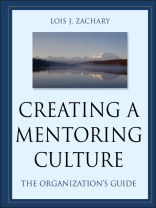In order to succeed in today’s competitive environment, corporate and nonprofit institutions must create a workplace climate that encourages employees to continue to learn and grow. From the author of the best-selling The Mentor’s Guide comes the next-step mentoring resource to ensure personnel at all levels of an organization will teach and learn from each other. Written for anyone who wants to embed mentoring within their organization, Creating a Mentoring Culture is filled with step-by-step guidance, practical advice, engaging stories, and includes a wealth of reproducible forms and tools.
Innehållsförteckning
Exercises.
Exhibits and Figures.
Foreword.
Preface.
Acknowledgments.
About the Author.
PART 1: TAKING STOCK: MENTORING’S FOUNDATION.
What Is Mentoring, Anyway?
Does Mentoring Add Value to the Organization?
How Do We Start?
1 Mentoring, Embedded in the Culture.
The Importance of Embedding Mentoring in the Culture.
An Ideal Scenario.
Phases of a Mentoring Relationship.
Embedding Mentoring: Reflection on Practice.
2 Connecting Culture and Mentoring.
Grounding the Work.
Identifying Cultural Anchors.
Deciding to Move Forward.
Where Do You Want to Be? Aligning Organizational and Mentoring Goals.
Connecting Culture and Mentoring: Reflection on Practice.
3 Planning Implementation.
Readiness, Opportunity, and Support: A Model for Change.
People and the Plan.
The Process of Implementation.
Planning Implementation: Reflection on Practice.
PART 2: MOVING FORWARD: MENTORING AT WORK.
The Hallmarks of Mentoring.
Moving Mentoring Forward.
4 Infrastructure.
Mentoring Infrastructure Components.
Infrastructure: Reflection on Practice.
5 Alignment.
Concepts and Challenges.
Characteristics of Alignment.
People: Powering Mentoring.
Process Components of Alignment.
Alignment: Reflection on Practice.
6 Accountability.
The Concept of Accountability.
Setting Goals.
Clarifying Expectations.
Defining Roles and Responsibilities.
Monitoring Progress and Measuring Results.
Gathering Feedback.
Formulating Action Goals.
Accountability: Reflection on Practice.
7 Communication.
Challenges of Communication.
Communication Criteria.
Benefits of Communication.
Components of Communication.
Communication: Reflection on Practice.
8 Value and Visibility.
Identifying the Value.
Showing Support Through Visibility.
Practices That Stimulate Value and Visibility.
Value and Visibility: Reflection on Practice.
9 Demand.
Creating Demand in a Mentoring Culture.
Impact and Indications of Demand.
What Factors Prevent Demand from Flourishing?
How Do Mentoring Hallmarks Contribute to Demand?
Demand: Reflection on Practice.
10 Multiple Mentoring Opportunities.
Planning the Opportunity.
Types of Mentoring Relationships.
From Opportunity to Planning.
Multiple Mentoring Opportunities: Reflection on Practice.
11 Education and Training.
Developing a Big-Picture Perspective.
Key Factors at Work.
Evaluating Your Key Factors.
Anatomy of a Training Experience.
Strategies for Success.
Education and Training: Reflection on Practice.
12 Safety Nets.
Relying on the Net.
Proactive Approaches to Obstacles.
Reactive Approaches to Obstacles.
Gaps in the Net.
Safety Nets: Reflection on Practice.
Epilogue: Moving on: Mentoring and the Future.
From Seed to Blossom.
From Blossom to Fruit.
Cultural Integration: A Caveat.
Reflection Is the Practice.
Appendix One: Mentoring Culture Audit.
Appendix Two: Digging Deeper.
References.
Index.
Credits.
How to Use the CD-ROM.
Om författaren
Lois J. Zachary is president of Leadership Development Services, LLC, a Phoenix-based consulting firm providing leadership development, coaching, education, and training for corporate and nonprofit organizations nationwide. She is a nationally recognized expert in mentoring. Her innovative mentoring approaches and expertise in coaching leaders and their organizations in designing, implementing, and evaluating learner-centered mentoring programs has made her an award-winning consultant. She is the author of the best-selling The Mentor’s Guide from Jossey-Bass.












